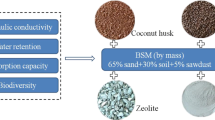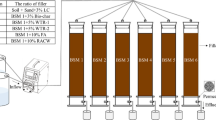Abstract
Bioretention systems have been proved to be a natural approach for effectively reducing stormwater runoff pollution loads. The filler is essential for the function of the bioretention systems; there are few studies on the use of biochar for bioretention. In this study, corn straw was used as raw material to prepare biochar bioretention-improved filler, and the optimal preparation scheme and filler proportioning method were determined. Three layered bioretention columns, i.e., BSM (bioretention soil media), BSM + 5%WTR (water treatment residues, w/w) and BSM + 5%CSC (corn straw biochar, w/w), were built to analyze its regulating effect on rainwater runoff. The DRAINMOD model was established based on the test results to analyze the regulating effect in different situations. The key parameters of the bioretention systems were optimized using response surface methodology (RSM). The results show that: BSM + 5%CSC was more stable than BSM + 5%WTR for water volume control effect and was better than BSM. The load reduction rates of BSM + 5%CSC was better than that of BSM and BSM + 5%WTR. When only considering the optimal nitrogen reduction effect, it was necessary to deepen the depth of the submerged area to improve the nitrogen control effect. When considering the optimal control effects of water volume and nitrogen, the thickness of the filler layer was the key factor affecting the water reduction rate. Overall, this study demonstrated that corn straw biochar can effectively improve the regulation effect of bioretention systems, and the optimization of parameters can provide references for the design of bioretention systems.







Similar content being viewed by others
Data Availability
All data generated or analyzed during this study are included in this published article.
Code Availability
Not applicable. No custom code required.
References
Achu, A. L., Thomas, J., & Reghunath, R. (2020). Multi-criteria decision analysis for delineation of groundwater potential zones in a tropical river basin using remote sensing, GIS and analytical hierarchy process (AHP). Groundwater for Sustainable Development, 10, 100365.
Berndtsson, J. C. (2010). Green roof performance towards management of runoff water quantity and quality: A review. Ecological Engineering, 36(4), 351–360.
Case, S., Mcnamara, N., Reay, D., & Whitaker, J. (2012). The effect of biochar addition on N2O and CO2 emissions from a sandy loam soil- The role of soil aeration. Soil Biology & Biochemistry, 51, 125–134.
Chen, S., & Chen, X. H. (2018). Urban rainwater runoff pollution and LID control effect simulation. Water Resources Protection, 34(05), 13–19. (In Chinese).
Dong, W. (2013). Research on the characteristics and control of non-point source pollution in northwestern cities-Taking Xi’an as an example. Xi'an University of Technology, Xi'an, China. (In Chinese)
Erickson, A. J., Gulliver, J. S., & Weiss, P. T. (2012). Capturing phosphates with iron enhanced sand filtration. Water Research, 46(9), 3032–3042.
Fletcher, T. D., Andrieu, H., & Hamel, P. (2013). Understanding, management and modelling of urban hydrology and its consequences for receiving waters: A state of the art. Advances in Water Resources, 51, 261–279.
Freni, G., Mannina, G., & Viviani, G. (2010). Urban storm-water quality management: Centralized versus source control. Water Resources & Planning Management, 136(2), 268–278.
Iqbal, H., Garcia-Perez, M., & Flury, M. (2015). Effect of biochar on leaching of organic carbon, nitrogen, and phosphorus from compost in bioretention systems. Science of the Total Environment, 521–522(jul.15), 37–45.
Li, B., Xie, J. C., Hu, Y. H., & Jiang, Y. G. (2016). Analysis on the trend and sudden change of precipitation and temperature in Xi’an in the past 60 years. South to North Water Diversion and Water Science and Technology, 14(2), 55–61. (In Chinese).
Li, C. H., Peng, C., Chiang, P. C., Cai, Y. P., Wang, X., & Yang, Z. F. (2018). Mechanisms and applications of green infrastructure practices for stormwater control: A review. Journal of Hydrology, 568, 626–637.
Li, J., Liang, N., Jin, X. Q., Zhou, D., Li, H., Wu, M., & Pan, B. (2017). The role of ash content on bisphenol A sorption to biochars derived from different agricultural wastes. Chemosphere, 171, 66–73.
Liu, J., David, S., Cameron, B., & Guan, Y. T. (2014). Review and research needs of bioretention used for the treatment of urban stormwater. Water, 6(4), 1069–1099.
Liu, Y. X., Gao, C. X., Wang, Y. Y., He, L. L., & Yang, S. M. (2020). Vermiculite modification increases carbon retention and stability of rice straw biochar at different carbonization temperatures. Journal of Cleaner Production, 254, 120111.
Lucke, T., & Nichols, P. W. B. (2015). The pollution removal and stormwater reduction performance of street-side bioretention basins after ten years in operation. Science of the Total Environment, 536, 784–792.
Lu, J. S., Cheng, Y., Zheng, Q., Du, Y., Wang, S. P., & Wang, J. P. (2010). Research on the formula of rainstorm intensity in Xi’an. China Water & Wastewater, 26(17), 82–84. (In Chinese).
Oni, B. A., Oziegbe, O., & Olawole, O. O. (2020). Significance of biochar application to the environment and economy. Annals of Agricultural Sciences, 64(2), 222–236.
Palanivel, R., & Mathews, P. K. (2012). Prediction and optimization of process parameter of friction stir welded AA5083-H111 aluminum alloy using response surface methodology. Journal of Central South University, 19(01), 1–8.
Petruni, A., Giagloglou, E., Douglas, E., Geng, J., Leva, M. C., & Demichela, M. (2019). Applying analytic hierarchy process (AHP) to choose a human factors technique: Choosing the suitable human reliability analysis technique for the automotive industry. Safety Science, 119, 229–239.
Redlich, O., & Peterson, D. L. (1959). A useful adsorption isotherm. Journal of Physical Chemistry, 63(6), 1024–1024.
Skaggs, W. R. (2012). DRAINMOD: Model use, calibration, and validation. Transactions of the ASABE, 55(4), 1509–1522.
Thines, K. R., Abdullah, E. C., Mubarak, N. M., & Ruthiraan, M. (2017). Synthesis of magnetic biochar from agricultural waste biomass to enhancing route for waste water and polymer application: A review. Renewable & Sustainable Energy Reviews, 67, 257–276.
Tian, J., Miller, V., Chiu, P. C., Maresca, J. A., Guo, M., & Imhoff, P. T. (2016). Nutrient release and ammonium sorption by poultry litter and wood biochars in stormwater treatment. Science of the Total Environment, 553(3), 596–606.
Uchimiya, M., Wartelle, L. H., Klasson, K. T., Fortier, C. A., & Lima, I. M. (2011). Influence of pyrolysis temperature on biochar property and function as a heavy metal sorbent in soil. Journal of agricultural and food chemistry, 59(6), 2501–2510.
Wang, J., & Wang, S. (2019). Preparation, modification and environmental application of biochar: A review. Journal of Cleaner Production, 227, 1002–1022.
Winston, R. J., Dorsey, J. D., & Hunt, W. F. (2016). Quantifying volume reduction and peak flow mitigation for three bioretention cells in clay soils in northeast Ohio. Science of the Total Environment, 553, 83–95.
Xiao, R., Awasthi, M. L., Li, R. H., Park, J., Pensky, S. M., Wang, Q., Wang, J. J., & Zhang, Z. Q. (2017). Recent developments in biochar utilization as an additive in organic solid waste composting: A review. Bioresource Technology, 246, 203.
Xiong, J., Ren, S., He, H., Wang, X. C., & Dzakpasu, M. (2019). Bioretention cell incorporating Fe-biochar and saturated zones for enhanced stormwater runoff treatment. Chemosphere, 237, 124424.
Zhao, Y., Li, Z., Pan, S. Y., Chiang, P., Pei, S., & Zhang, S. J. (2019). Performance evaluation of modified bioretention systems with alkaline solid wastes for enhanced nutrient removal from stormwater runoff. Water Research, 161, 61–73.
Acknowledgements
We gratefully thank all the members of the research group on Non-Point Source Pollution Control and Sponge City of the State Key Laboratory of Eco-hydraulics in Northwest Arid Region of China for their efforts in water quality test.
Funding
This work was financially supported by the National Natural Science Foundation of China (52070157) and Natural Science Foundation of Shaanxi Province (2019JM-347).
Author information
Authors and Affiliations
Contributions
Li Jiake, Liu Fang, and Li Yajiao contributed to the study conception and design. Material preparation, data collection, and analysis were performed by Li Jiake, Li Ning, Liu Fang, and Li Yajiao. The first draft of the manuscript was written by Li Jiake and Li Ning. All authors read and approved the final manuscript.
Corresponding author
Ethics declarations
Ethics Approval
Not applicable. No animal or human participants.
Consent to Approval
Not applicable. No animal or client participants.
Consent for Publication
Not applicable. No individual person’s data in any form.
Conflict of Interest
The authors declare no competing interests.
Additional information
Publisher's Note
Springer Nature remains neutral with regard to jurisdictional claims in published maps and institutional affiliations.
Supplementary Information
Below is the link to the electronic supplementary material.
Rights and permissions
About this article
Cite this article
Li, J., Li, N., Liu, F. et al. Development and Optimization of Bioretention Systems with Modified Fillers of Corn Straw Biochar. Water Air Soil Pollut 232, 383 (2021). https://doi.org/10.1007/s11270-021-05330-w
Received:
Accepted:
Published:
DOI: https://doi.org/10.1007/s11270-021-05330-w




